Categories
Archives

The Media Provenance Summit brought together leading experts, journalists and technologists from across the globe to Mount Fløyen in Bergen, Norway, to address some of the most pressing challenges facing news media today.
Hosted by Media Cluster Norway, and organised together with the BBC, the EBU and IPTC, the full-day summit on September 23 convened participants from major news organisations, technology providers and international standards bodies to advance the implementation of the C2PA content provenance standard, also known as Content Credentials, in real-world newsroom workflows. The ultimate aim is to strengthen the signal of authentic news media content in a time where it is challenged by generative AI.
“We need to work together to tackle the big problems that the news media industry is facing, and we are very grateful for everyone who came together here in Bergen to work on solutions. I believe we made important progress,” said Helge O. Svela, CEO of Media Cluster Norway.
The program focused on three critical questions:
- How to preserve C2PA information throughout editorial workflows when not all tools yet support the technology.
- When to sign content as it moves through the workflow at device level, organisational level, or both.
- How to handle confidentiality and privacy issues, including the protection of sources and sensitive material.
“We were very happy to see a focus on real solutions, with some great ideas and tangible next steps,” said IPTC’s Managing Director, Brendan Quinn. “With participants from across the media ecosystem, it was exciting to see vendors, publishers, broadcasters and service providers working together to address issues in practically applying C2PA to media
workflows in today’s newsrooms.”
Speakers included Charlie Halford (BBC), Andy Parsons (CAI/Adobe), François-Xavier Marit (AFP), Kenneth Warmuth (WDR), Lucille Verbaere (EBU), Marcos Armstrong and Sébastien Testeau (CBC/Radio-Canada), and Mohamed Badr Taddist (EBU).
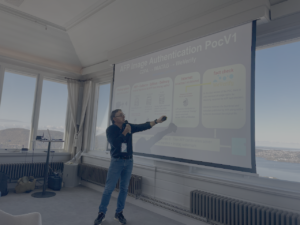
“The BBC welcomes this focus on protecting access to trustworthy news. We are proud to have been founder members of the media provenance work carried out under the auspices of C2PA and we are delighted to see it moving forward with such strong industry support,” said Laura Ellis, Head of Technology Forecasting at BBC Research.
Participants travelled to participate in the summit from as far away as Japan, Australia, the US and Canada.
“We’re pleased to collectively have taken a few hurdles on the way to enabling a broader adoption of Content Provenance and Authenticity”, said Hans Hoffmann, Deputy Director at EBU Technology and Innovation Department. “The definition of common practices for signing content in workflows, retrieving provenance information thanks to soft binding, and better safeguards for the privacy of sources address important challenges. Public service media are committed to fight disinformation and improve transparency, and EBU members were well represented in Bergen. The broad participation from across the industry and globe
smooths the path towards adoption. Thanks to Media Cluster Norway for hosting the event!”
The summit emphasised moving from problem analysis to solution exploration. Through structured sessions, participants defined key blockers, sketched practical solutions and developed action plans aimed at strengthening trust in digital media worldwide.
About the Summit
The Media Provenance Summit was organised jointly by Media Cluster Norway, the EBU, the BBC and IPTC, and made possible with the support of Agenda Vestlandet.
For more information, please contact: helge@medieklyngen.no
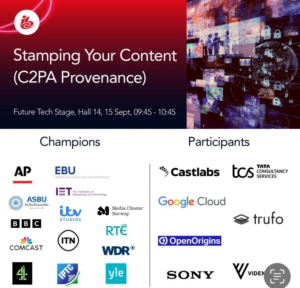 The IPTC has joined the BBC (UK), YLE (Finland), RTÉ (Ireland), ITV (UK), ITN (UK), EBU (Europe), AP (USA/Global), Comcast (USA/Global), ASBU (Africa and Middle East), Channel 4 (UK) and the IET (UK) as a “champion” in the Stamping Your Content project, run by the IBC Accelerator as part of this year’s IBC Conference in Amsterdam.
The IPTC has joined the BBC (UK), YLE (Finland), RTÉ (Ireland), ITV (UK), ITN (UK), EBU (Europe), AP (USA/Global), Comcast (USA/Global), ASBU (Africa and Middle East), Channel 4 (UK) and the IET (UK) as a “champion” in the Stamping Your Content project, run by the IBC Accelerator as part of this year’s IBC Conference in Amsterdam.
These “Champions” represent the content creator side of the equation. The project also includes “participants” from the vendor and integrator community: CastLabs, TCS, Videntifier, Media Cluster Norway, Open Origins, Sony, Google Cloud and Trufo.
This project aims to develop open-source tools that enable organisations to integrate Content Credentials (C2PA) into their workflows, allowing them to sign and verify media provenance. As interest in authenticating digital content grows, broadcasters and news organisations require practical solutions to assert source integrity and publisher credibility. However, implementing Content Credentials remains complex, creating barriers to adoption. This project seeks to lower the entry threshold, making it easier for organisations to embed provenance metadata at the point of publication and verify credentials on digital platforms.
The initiative has created a proof-of-concept open source ‘stamping’ tool that links to a company’s authorisation certificate, inserting C2PA metadata into video content at the time of publishing. Additionally, a complementary open-source plug-in is being developed to decode and verify these credentials, ensuring compliance with C2PA standards. By providing these tools, the project enables media organisations to assert content authenticity, helping to combat misinformation and reinforce trust in digital media.
This work builds upon the “Designing Your Weapons in the Fight Against Disinformation” initiative at last year’s IBC Accelerator, which mapped the landscape of digital misinformation. The current phase focuses on practical implementation, ensuring that organisations can start integrating authentication measures in real-world workflows. By fostering an open and standardised approach, the project supports the broader media ecosystem in adopting content provenance solutions that enhance transparency and trustworthiness.
Attend the project’s panel presentation session at the International Broadcasting Convention, IBC2025 in Amsterdam on Monday, Sept 15 at 09:45 – 10:45.
The speakers on the panel on Monday September 15 are all from IPTC member organisations:
- Henrik Cox, Solutions Architect – OpenOrigins
- Judy Parnall, Principal Technologist, BBC Research & Development – BBC
- Mohamed Badr Taddist, Cybersecurity Master graduate, content provenance and authenticity – European Broadcasting Union (EBU)
- Tim Forrest, Head of Content Distribution and Commercial Innovation – ITN
See more detail on the IBC Show site.
Many of the participating organisations are also IPTC members, so the work started in the project will continue after IBC through the IPTC Media Provenance Committee and its Working Groups.
We are already planning to carry this work forward at the next Media Provenance Summit which will be held later in September in Bergen, Norway.
Google has announced the launch of its latest phone in the Pixel series, including support for IPTC Digital Source Type in its industry-leading C2PA implementation.
Many existing C2PA implementations focus on signalling AI-generated content, adding the IPTC Digital Source Type of “Generated by AI” to content that has been created by a trained model.
Google’s implementation in the new Pixel 10 phone differs by adding a Digital Source Type to every image created using the phone, using the “computational capture” Digital Source Type to denote photos taken by the phone’s camera. In addition, images edited using the phone’s AI manipulation tools show the “Edited using Generative AI” value in the Digital Source Type field.
Note that the Digital Source Type information is added using the “C2PA Actions” assertion in the C2PA manifest; unfortunately it is not yet added to the regular IPTC metadata section in the XMP metadata packet. So it can only be read by C2PA-compatible tools.
Background: what is “Computational Capture”?
The IPTC added Computational Capture as a new term in the Digital Source Type vocabulary in September 2024. It represents a “digital capture” that does involve some extra work using an algorithm, as opposed to simply recording the encoded sample hitting the phone sensor, as with simple digital cameras.
For example, a modern smartphone doesn’t simply take one photo when you press the shutter button. Usually the phone captures several images from the phone sensor using different exposure levels and then an algorithm merges them together to create a visually improved image.
This of course is very different from a photo that was created by AI or even one that was edited by AI at a human’s instruction, so we wanted to be able to capture this use case. Therefore we introduced the term “computational capture”.
For more information and examples, see the Digital Source Type guidance in the IPTC Photo Metadata User Guide.

“As content becomes commoditised, there will be a trend towards authentic, human-created work,” said Scott Belsky at the 2025 Content Authenticity Summit, held last week on Roosevelt Island, New York.
Over 200 authenticity experts from over 150 companies joined together at the Cornell Tech campus in New York City on Wednesday 4th June to share the latest work of those implementing C2PA in the industry.
The theme of the event was real-world implementation of C2PA and spreading the word about Content Credentials, the user-facing brand of the C2PA technology.
The event was co-presented by IPTC along with the Content Authenticity Initiative (CAI) and the Coalition for Content Provenance and Authenticity (C2PA)
Highlights were:
- The launch of the C2PA Conformance programme, which will allow device and software implementers to be able to obtain certificates on the official C2PA Trust List (after the current Temporary Trust List is shut down later in 2025)
- A talk from Bruce MacCormack of CBC / Radio Canada, Chair of the IPTC Media Provenance Committee, on how the media industry is implementing C2PA, and the importance of publisher branding and organisational stamping of content at publish time to prevent brand hijacking and misattribution of news content
- An in-depth discussion of the IPTC Origin Verified News Publisher programme, including the launch of the IPTC guidance document helping news publishers to implement C2PA
- Another deep-dive workshop looking at which metadata fields should be included in C2PA-signed content. The discussion covered both metadata about the publisher and metadata about the content itself.
- Eight simultaneous tracks of breakout sessions covering device conformance, implementation in the news industry, real-world deployments on Amazon Web Services, work on standardisation with ISO and other bodies,
- A fast-paced and wide-ranging presentation from UC Berkeley professor Hany Farid on the importance of authenticity and the difficulty of keeping up with deepfake detection in our world of ever-improving generative AI models
- The many and varied discussions among attendees around their own effort to implement C2PA technology within their newsrooms
The most common feedback that we heard from attendees was that participants would have liked to be at all of the breakout sessions at the same time!
The event was held under the Chatham House Rule, which means that detailed recordings will not be available, although anonymised workshop summaries will soon be made available to attendees.
For more information about C2PA, the Media Provenance Committee or the Verified News Publisher List, please contact IPTC directly.
The International Press Telecommunications Council (IPTC) is proud to co-host the 2025 Content Authenticity Summit, along with the Coalition for Content Provenance and Authenticity (C2PA) and the Content Authenticity Initiative (CAI). The event will be held tomorrow, Wednesday 4 June at the Cornell University campus on Roosevelt Island, New York City.
The Content Authenticity Summit will convene over 200 of the world’s foremost experts on digital content provenance including implementers, creators, and policymakers for a one-day series of presentations, panels, breakout sessions, and hands-on demonstrations to highlight the latest developments in this essential and fast-moving space.
The Summit, presented by the Content Authenticity Initiative, the Coalition for Content Provenance and Authenticity, and the International Press Telecommunications Council, will highlight current opportunities and challenges focused on driving broad awareness and adoption of Content Credentials.

Brendan Quinn, Managing Director of IPTC, will be hosting two workshops at the Content Authenticity Summit.
Many other IPTC members will also be represented:
- Adobe will have many representatives at the event, including Andy Parsons, Eric Scouten, Pia Blumenthal and Leonard Rosenthol
- Bruce MacCormack of CBC / Radio Canada, Chair of the Media Provenance Committee, will speak about C2PA adoption in the news media
- Helge O. Svela, CEO of Media Cluster Norway will co-host workshops on C2PA in the news industry.
- AFP and IMATAG will present a case study on their project to digitally sign content
- Charlie Halford of the BBC will co-host the workshop on C2PA metadata in the news industry
- Will Kreth of HAND Identity will be speaking about how provenance protects the identities of athletes and entertainers
- Sherif Hanna of Google will be speaking about the forthcoming C2PA Conformance process.
Other speakers include representatives from Meta, LinkedIn, OpenAI, Partnership on AI and Nikon.
We will report on the event later this week. If you’re attending, come and say hello to our members and to IPTC Managing Director Brendan Quinn.
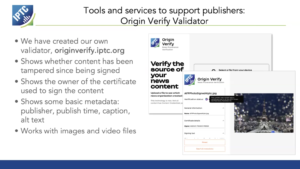
Brendan Quinn of IPTC presented alongside Leonard Rosenthol of C2PA at the World-Wide Web Consortium (W3C)’s Authentic Web workshop series this week.
This was the second in a series of online workshops run by the W3C in an effort to bring together the various work on trust, provenance, credibility and authenticity. The first part of the Authentic Web workshop was run in March 2025.
Leonard presented C2PA, its motivations and work done so far, including describing how C2PA technology is currently used by platforms such as LinkedIn and TikTok, and by most generative AI tools to signal AI-generated content.
Then Brendan went on to describe how the IPTC’s Media Provenance Committee has established the Verified News Publisher programme, an industry specific “trust list” of media organisations who are using C2PA certificates to sign their published content.
W3C events mostly run in the open, so the session agenda, pre-read material, minutes and even a video recording of the presentation part of the workshop are all available online, even to non-members. As per W3C policy, the discussion portion of the event was not recorded. This allows for more open discussion.
Present at the workshop were representatives of Google Chrome and Mozilla, the W3C’s Technical Architecture Group (TAG), hardware and software vendors, and others with an interest in the idea of implementing content provenance solutions in their tools.
Depending on the outcome of discussions within the group and at further workshops, this work may lead to a physical meeting later this year.

The following is a guest post from Helge O. Svela, CEO of Media Cluster Norway. Media Cluster Norway joined the IPTC as Associate Members of IPTC in 2024 and Helge is the lead of the Provenance Best Practices and Implementation Working Group, where news publishers work together to talk about their progress in implementing C2PA and the IPTC Verified News Publisher programme within their organisations.
In this article, Helge introduces Project Reynir, an initiative to bring secure media signing technology to the Norwegian media industry.
The journalistic institution must rethink how it develops and applies technology if society is to stand a chance against the deluge of fake images and video from generative AI. Never before in human history has it been easier to produce realistic, but fake, images and video, and spread them around the world. The rapid technological development of generative artificial intelligence has turbocharged the engines of disinformation, and caught both society and journalism off-guard. Never have we been more vulnerable.
Disinformation is destabilising our democracies, and spreading erroneous information. This potentially has severe consequences for both democratic processes and for the public in the face of natural disasters and other crises. The first round of the Romanian elections in 2024 was annulled due to what was dubbed an “algorithmic invasion” of social media disinformation. In the aftermath of the earthquake in Myanmar in March, AI-generated videos of the devastating destruction shared by so called “engagement farmers”, likely with financial motives, got millions of views on social media.
Generative AI has given humanity the ability to create realistic videos and images simply by typing a few words into a website. However, these tools also quickly became a part of the arsenal for enemies of democracy. As a result, disinformation is becoming more prevalent, appearing more professional and costing almost nothing to produce. Generative AI is an industrial revolution also for the troll factories in Russia and others who seek to manipulate our perception of the world and sow doubt about what is true.
This is not a media problem. It is a democratic problem, and a dangerous one at that. Disinformation created by troll factories and generative artificial intelligence and spread by bots pose an immediate threat to our democracies. We might end up doubting absolutely everything. When anyone can claim anything is generated and fake, the liars come out on top. This could destroy the foundation of our democracies: trust in each other and in our institutions. One thing is current news, another is history. Imagine a dictator using fake historical footage of a hunger catastrophe in order to justify an ethnic cleansing of a minority. An internet flooded with claims and visual “proof” of what happened in the past, all of which looks authentic. As a result of generative AI this is no longer just a dystopian science fiction scenario. It is a real possibility. Never before have we needed editorial media more. However, the signal strength of editorial media risks being drowned out by an ever growing cacophony of junk content and disinformation.
Project Reynir is our response to the threat Generative AI poses. Because Generative AI makes it so easy to fake both content and sender, editorial media are under threat on two fronts. In Project Reynir, we aim to solve this problem using technical solutions.
The goal is to create something that makes it easier for ordinary people to distinguish between what is fake and what is real. By using cryptographically secured images and video, based on the open C2PA specification, it is possible for both newsrooms and regular media users to be confident that the images we are seeing have not been tampered with on their journey from the photographer’s lens to the mobile screen. Moreover, using the same technology, authenticity markers can be added to the images and videos from news publishers when they post stories on social media and other third party platforms. Thus guaranteeing that content that appears to be the BBC and AFP actually is from these news organisations and not someone impersonating them. If we succeed, we will be a significant step closer to solving the problem of artificially created noise for our present moment. Project Reynir unites newsrooms, media technology companies and academic researchers in the fight against disinformation. Our goal is an 80 percent adoption in the Norwegian news ecosystem, and to serve as a beacon of best practices for the rest of the world of news.
We believe that time is critical, and that all good forces now must unite. The technological development has moved rapidly in the last few years, and the adoption of technology has sometimes been irresponsible. If our democracies are to stand firm in the face of the disinformation tsunami we are facing, quality journalism must be empowered. Only then can we enable citizens to make informed choices free of manipulation and interference, in an environment where facts can be easily distinguished from lies. We call for the democratic governments of the world to invest in innovation in the news media space. The time for responsible tech innovation, made with resilient democracies in mind, is now.
This article was originally published in the report Seeking Truth, Ensuring Quality: Journalistic Weapons in the Age of Disinformation, published by the University of Bergen in collaboration with Media Cluster Norway, as a part of the Journalistic Weapons conference organised in Brussels on April 28 2025. The full report, including articles from Faktisk, the European Federation of Journalists, London School of Economics, the Center for Investigative Journalism Norway and others, is available at https://www.uib.no/sites/w3.uib.no/files/attachments/publication_seeking_truth_ensuring_quality.pdf.
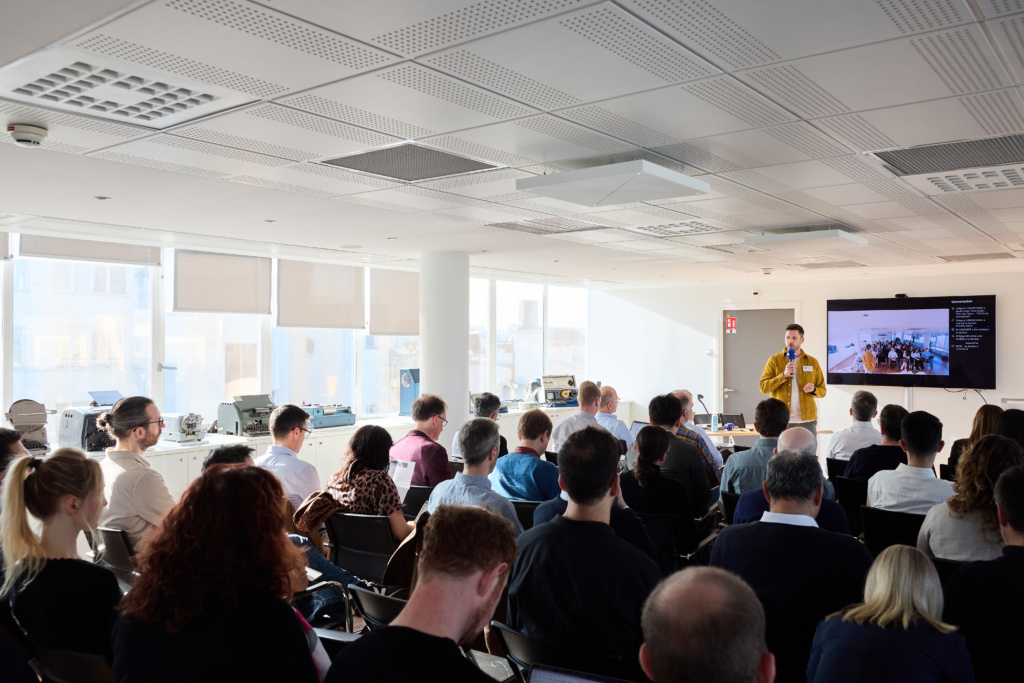
“It has never been more important to safeguard authentic news media,” say the organisers.
“We must strengthen our voice and hold our ground against the big tech players. It is critical that the industry works together,” said Fabrice Fries, Chief Executive Officer at AFP, in his opening remarks for the workshop in Paris.
“At AFP we are committed to ensure that both news organisations and the general public can inspect the provenance of our images. This transparency builds trust,” said Eric Baradat, the global news deputy director for photo and archives at AFP.
AFP, BBC and Media Cluster Norway jointly organised the workshop, which was hosted by AFP and supported by the International Press Telecommunications Council (IPTC). The workshop focused on image metadata and how the C2PA standard, also known as Content Credentials, can safeguard it.
“The challenges the news industry are facing are so great that we can only succeed if we work together. Making sure the public can discern between authentic media and content made by generative AI is vital not only for news organisations, but for democratic societies,” said Helge O. Svela, CEO of Media Cluster Norway.
More than 40 people from over 20 news organisations participated in the full day workshop. Among the presentations was a study commissioned by Media Cluster Norway’s Project Reynir on how media consumers respond to being shown more detailed information about an image. The study was conducted by MediaFutures at the University of Bergen, and built on a user study conducted by the BBC.
“Trust is earned. At the BBC we have seen that users really engage when we show them how their news was made. Extra media provenance details such as when and where an image was taken, or the steps used to verify it, make a real difference to how users trust their news. The C2PA standard can allow us to share this information with the users in a secure and trustworthy way,” said Judy Parnall, Principal Technologist, BBC Research and Development.
Among the participants in the workshop were CBC-Radio Canada, Deutsche Welle, France TV, ITV, NHK and Al Jazeera. Topics discussed included carrying provenance metadata from glass to glass versus adding it at the point of publishing, as well as the importance of redaction to the media industry and content provenance for media archives.
“It is vital that the needs of the news media ecosystem are heard as this technology and standards are further developed and refined,” said Brendan Quinn, Managing Director at IPTC.
The IPTC Media Provenance Committee works on several initiatives for implementing and furthering the development of the C2PA technology for the media industry. Many of the speakers and participants of the Paris workshop are actively involved in this work.
For more information on IPTC and the Media Provenance Committee, contact the IPTC via this site.

The IPTC has developed a WordPress plugin that automatically signs all images and video content published on a WordPress site. It has been put to use to automatically sign all images attached to IPTC news posts, such as this one, at the moment of publishing.
Based on our library of signing tools which are available to IPTC members, the “C2PA Signer” plugin takes action when a WordPress user publishes a new post. The plugin automatically retrieves all images (in all available sizes) and signs each image using the private key associated with the publisher.
The tool also extracts relevant metadata from WordPress. Each image’s caption, alt text, image upload date and publish date are embedded into the signed C2PA Manifest using an early version of the Origin IPTC Verified News Publisher metadata assertion. The specification of this assertion is currently in flux and the example assertion should not be relied on for production use, although the assertion is supported by the IPTC’s C2PA validator tool, Origin Verify.
Click here to view the image’s signed metadata using the Origin Verify tool.
This is in line with the goals of our IPTC Origin Verified News Publisher project, whereby publishers sign their own content using their own certificate. This enables publishers to take ownership of their content and to assert important facts about their content at the time of publishing.
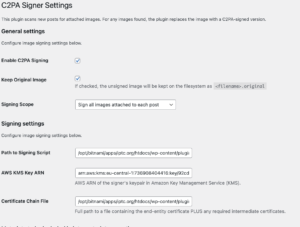 |
 |
In related news, the IPTC now has its own C2PA certificate, issued by GlobalSign under the IPTC’s official name, “Comite International des Telecommunications de Presse.” This means that the IPTC can be the first entity to use the new plugin.
“We are very happy to launch the new WordPress plugin, which we of course are using on our own website,” says Brendan Quinn, Managing Director, IPTC. “We believe that this makes us the first organisation to routinely sign all images that we publish using our C2PA credentials.”
The certificates, manifests and the signed content are fully compatible with the latest version of C2PA, version 2.1. Images that we publish (including the image on this post) can be verified using the Origin Verify validator or the C2PA Content Credentials Verify validator.
For more information, contact IPTC using the Contact Us form.

AMSTERDAM, 13 September 2024 — The International Press Telecommunications Council (IPTC) has announced Phase 1 of the IPTC Verified News Publishers List at the International Broadcast Convention (IBC).
The list uses C2PA technology to enable verified provenance for the news media industry. News outlets apply for a certificate from a partner Certificate Authority (currently Truepic), with the IPTC verifying the identity of the publisher. The certificate is then used by the news outlet to sign content, in accordance with the C2PA specification’s handling of “additional trust anchor stores”. This means that the news publisher is the signer of the content. This is a key requirement for many media outlets.
Currently the BBC (UK), CBC / Radio Canada (Canada) and broadcaster WDR (Germany) have certificates on the Verified News Publishers List. Many more publishers and broadcasters are currently in the process of obtaining a certificate. To register your interest as a news publisher, please fill out the Verified News Publisher expression of interest form.
To make the process of verifying and approving certificate requests transparent and accountable, the IPTC has released a set of policies for issuing Verified News Publisher certificates covering Phase 1 of the project. The process includes a “fast track” process for media organisations that are already well known to IPTC, and also a self-certification track. The policies were approved by the IPTC membership at a recent meeting of the IPTC Media Provenance Committee.
Verifying publisher identity, not trustworthiness
Note: as we have always made clear, the IPTC is making no claims about the truth or trustworthiness of content published by news publishers on the IPTC Verified News Publisher List. We simply verify that the publisher is “who they say they are”, and then the signature will verify that the content was published by that publisher, and has not been tampered with since the point of publishing.
We make it clear in the governance policies that a certificate can be revoked if the certificate’s private key has been compromised in some way, but we will not revoke certificates for editorial reasons.
Online verifier tool
The IPTC has worked with the BBC to launch a simple Verified News Publisher content verifier tool hosted at https://originverify.iptc.org. The tool displays a special indicator when content has been signed by an organisation whose certificate is on the Verified News Publisher list. The IPTC has also published a set of Verified News Publisher sample content that can be used with the verifier to demonstrate the process in action.
Sharing best practices, resources and knowledge among news publishers
For IPTC members, the Media Provenance Committee has created an internal members-only wiki detailing best practices and lessons learned while implementing C2PA and the Verified News Publisher List at broadcasters and publishers. Information on the wiki includes technical details on how to generate a certificate signing request to obtain a certificate, how to sign content with open-source and commercial tools, how to deal with publishing and distribution technology such as streaming servers and content delivery networks, and how to add metadata to C2PA assertions embedded in media content.
The Committee has also created a public-facing area of the IPTC site describing IPTC’s work in the area of Media Provenance, helping news publishers to get up to speed and understand how C2PA technology works and how it can be implemented in publishing workflows.
Other IPTC and Media Provenance-related events at IBC this weekend:
- Judy Parnall (BBC), Lead of the IPTC Media Provenance Advocacy Working Group, spoke on a panel on “Content Tracing and Provenance” this morning (Friday) at the AI Zone.
- Judy is also presenting a paper at the IBC Conference on Saturday 14 September: Provenance: What can we Trust?, along with IPTC Individual Member John Simmons.
- Combating disinformation in News: A critical year for democracies at the IPTC Conference on Saturday. Laura Ellis (BBC) is on the panel along with representatives from CBS and GLOBO.
- On Sunday 15 September, Judy presents IBC’s Accelerator Project “Design Your Weapons in Fight Against Disinformation” on the IBC Innovation Stage, along with tech leaders from CBS, Associated Press and ITN.
